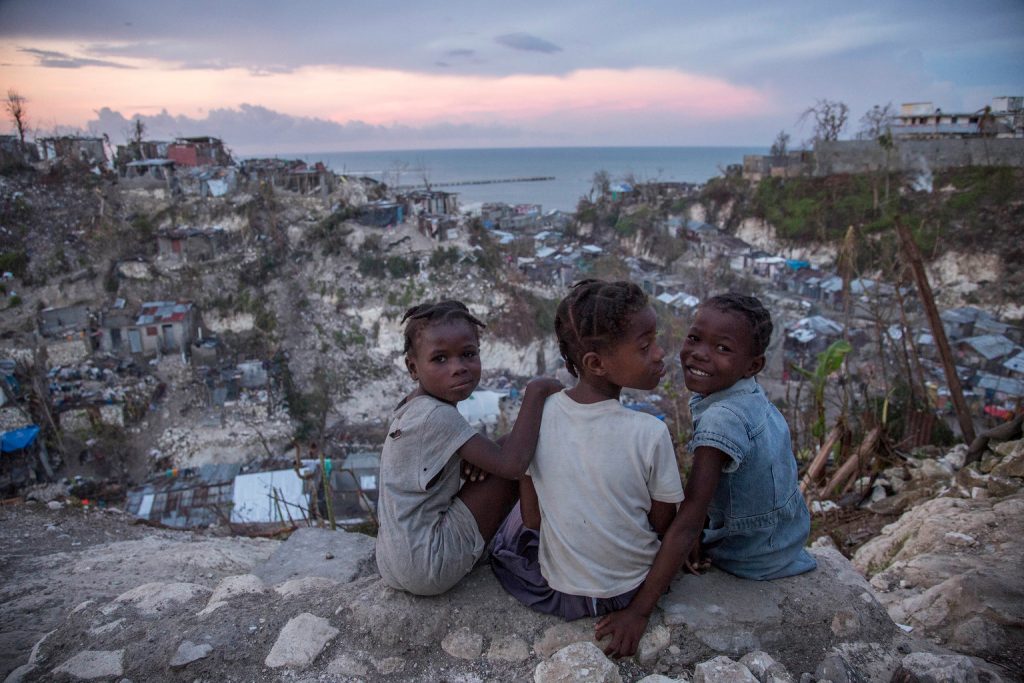9,000 people died in Haiti’s last cholera outbreak. We must act fast in disaster-affected hotspots to help prevent history repeating itself.
Article
Hurricane Matthew: Haiti Needs Vaccines to Stop Deadly Cholera Spreading
Countries
Haiti
On 13 October 2016 in Jérémie, Haiti, (right) Mylove Théogène, 8, sits with other girls near her home. Myloves family stayed in their home on a hilltop until their home collapsed around 5:00am on the night Hurricane Matthew struck Haiti. Then, the family then moved to a school house for shelter. "I thought I was going to die. I thought my family would all die" said Mylove. The family of five lost their father in February 2016, when he fell from a tree while collecting fruit for the family to eat. "When I grow up I want to go to school" Mylove remarks as a second-grader who has not been to school at all in 2016. More than one week after Hurricane Matthew, as schools re-open across the country, more than 100,000 children will be missing out on learning after their schools were either damaged or converted into shelters.
Hurricane Matthew passed over Haiti on Tuesday October 4, 2016, with heavy rains and winds. While the capital Port au Prince was mostly spared from the full strength of the class 4 hurricane, the western area of Grand Anse, however was in the direct path. The cities of Les Cayes and Jeremie received the full force sustaining wind and water damage across wide areas. Coastal towns were severely damaged as were many homes in remote mountainous regions. International relief efforts are underway to provide food water and shelter to the people affected by the storm.
An estimated 500,000 children live in the Grande Anse Department and Grand South Department in southern Haiti, the areas worst hit by Hurricane Matthew. UNICEF had prepositioned emergency supplies with national authorities to reach up to 10,000 people. On 8 October, six water trucks arrived in Jeremie and Les Cayes, the respective capital cities within the Departments. Additional water and sanitation supplies, such as water purification tablets, water bladders and plastic sheeting, have been dispatched to the most affected departments in the westernmost tip of Haiti. As of 10 Oct
Related content
Case study
SSHAP learning note: Building a localised approach
This learning note shares insights, experiences and lessons from SSHAP's approach to the localisation of its operational responses in sub-Saharan Africa.
Central and East Africa Hub
West Africa Hub
SSHAP
2025
Evidence review
Rapid evidence synthesis: Mpox community protection
This note presents a rapid synthesis of evidence related to community protection in countries affected by the mpox clade 1b outbreak. Synthesising evidence related to community protection for mpox Medline, Africa Journals Online and Global Index Medicus were searched. IFRC,…
SSHAP
2025
Report
Meeting report: The impact of global aid funding cuts on people and programmes in South Sudan
Report of a roundtable with government actors, academics, development partners and journalists in South Sudan on the sweeping impacts on people and programmes of aid cuts and multiple, intersecting crises.
Central and East Africa Hub
SSHAP
2025
Briefing
Key considerations: Home-based care for mpox in Central and East Africa
This brief outlines key considerations on health system requirements for safe and inclusive home-based care for mpox.
Central and East Africa Hub
SSHAP
2025


